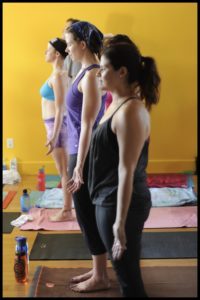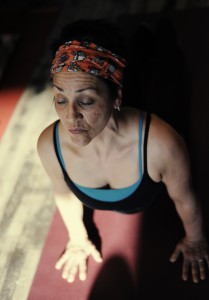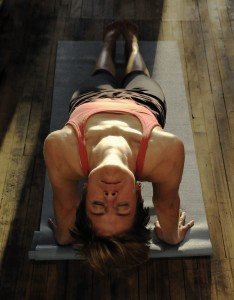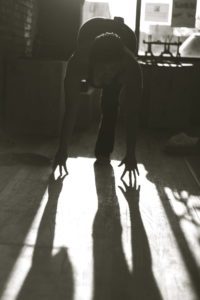If you’ve practiced yoga for any period of time you’ve likely struggled with creating a home practice.
We can eagerly book our personal calendars to attend classes around town to take from various teachers without hesitation.
Our practice feels strong and committed and deeper every time we roll out our mat.
We tell ourselves that the community aspect is a draw for practicing in a studio setting. It becomes a social event while connecting with spirit.
There’s nothing wrong with any of that. We want to cultivate sangha – community of like-minded action.
But we also know it can become a thinly veiled excuse for not taking our practice to another level – a home practice, a self-practice, an internalized practice. I firmly believe our path leads us to our personal form of yoga. After a while you’re not practicing Bikram or Iyengar or Anusara – that’s their yoga. You’re honing your way to finding and expressing YOUR yoga.
But that means we eventually have to start a self practice.
Why is it so hard to roll out our mats and practice on our own? Why does doing yoga have to mean going somewhere other than where we are? Isn’t the practice an inward journey?
It’s taken me quite a while to develop a twice a week self practice.
I thought it would be easier.
As a tai chi practitioner I never lacked the discipline to find my form several times a day wherever I wanted.
But the form is just that – a set sequence. My body has muscle memory and I allow the energy to flow through. There is no thinking.
In my asana practice the empty mat and no one telling me what to do represented a blank canvas on the stage of an empty performance hall. I was confronted with the silence that revealed my noisy mind.
Some immediate realizations about the empty mat:
- It can make you nervous. What postures should I be doing? What would feel good? What should the sequence look like or feel like.
- It can make you afraid. Maybe I won’t do the posture right. I will probably look silly.
- It can make you critical and frustrated (particularly when you notice these emotions as you’re trying to practice and you become self conscious or disappointed in what you thought was a strong practice)
You roll up your mat and leave. I did. Many times. Sometimes rolled up grabbed the keys and ran to a studio.
I relied on the pattern of my tai chi form to get me rolling with a self practice in yoga by practicing ashtanga at home. I didn’t need to think about the postures and what to do next. It was all laid out for me.
Then I started to bring another aspect of my tai chi form into my mat practice – play. I was taught to refer to my tai chi practice as play. I play the form. I play tai chi. It’s a musical reference as well as a state of mind and being. It should be playful and it should flow like notes from an instrument.
So I took an element of play into my mat time after becoming comfortable exploring ashtanga. Going off sequence after the sun salutes in an exploratory way at first. It felt tentative and even a little forbidden (would ashtanga police suddenly appear in my room and wag a finger at me for breaking sequence?). Then exploration became experimentation. Can I go from vasisthasana to parivritta parsvakonasana? Could I float from astavakrasana to eka pada koundinyasana without my feet touching the floor? Could I go from there into bakasana?
Did I learn a lot? Sure did.
Here’s a few tips I’d give toward cultivating a self-practice:
- Don’t set a time goal. Often we close the door to ourselves before we get started by setting a goal. Then if we don’t meet it, we’re disappointed. Or we’re looking at the clock the whole time, distracted from practice.
- Set a thematic or mantra. Breath. Balance. Rootedness. A single chakra. And just focus on that through your practice.
- Consistent location. I’m not going to say it needs to be perfectly serene, quiet, clean, etc…because if it’s your house, you know there’s no such perfect spot. Just keep it consistent.
- Have a travel mat. A light travel mat makes it possible to take your yoga with you on trips.
- Travel speakers/mp3. Find a cheap light pair of speakers (that can operate by battery or power cord) and get an mp3 player or use your smart phone. I like to have the Sutras being chanted or some light Indian flute music. (I use a JVC portable set of speakers)
- Don’t try to emulate your studio class. It’s not the studio class. It’s your own free flow.
- Listen to yoga podcasts. Start listening to yoga rather than watching DVDs. You’ll begin to tune in at least to listening – removing sight as a sense (pratyahara) (I particularly enjoy Dave Farmar)
- Find a Mysore class or free flow class in your community. Start to practice among people who are practicing with you but not saying anything.
- Be OK if your practice goes in a different direction than what you thought. Be flexible. If you suddenly find yourself in seated meditation instead of working on inversions, that’s what you were meant to do that day
Do you have a home practice? A solid one? A hit-or-miss one? Please feel free to share your advice, tips, successes and challenges with us here.
Practice your practice.
(Just B Yoga offers a Free Flow class several times a week. Check the schedule for times)
–Photos @2011 Copyright McShane Photography—




